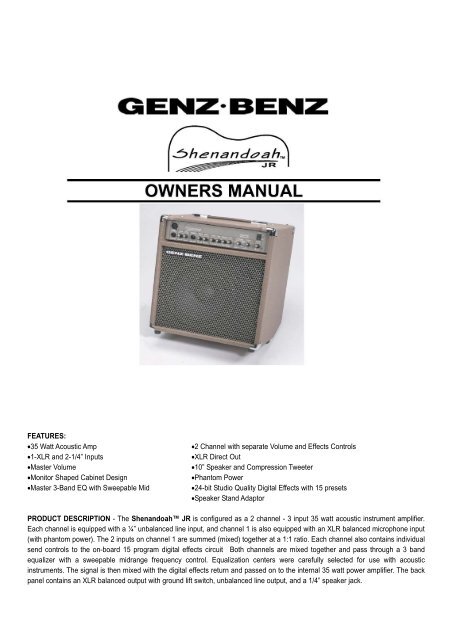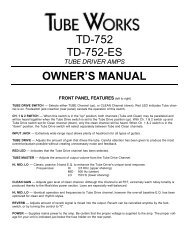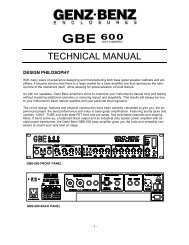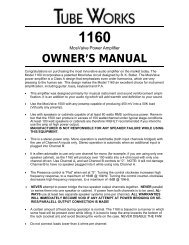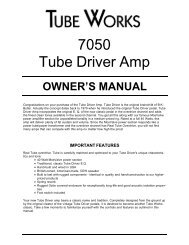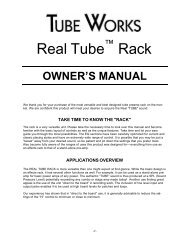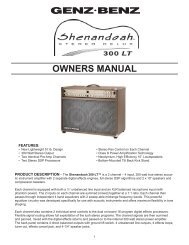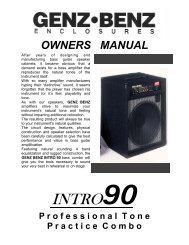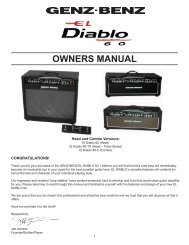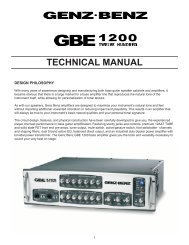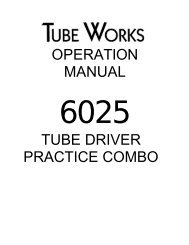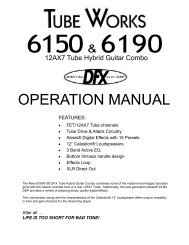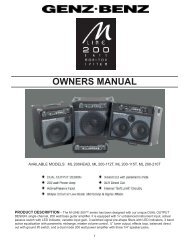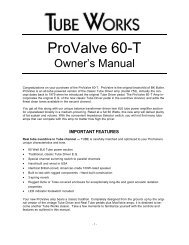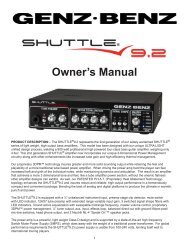FEATURES: •35 Watt Acoustic Amp •2 Channel with ... - Genz Benz
FEATURES: •35 Watt Acoustic Amp •2 Channel with ... - Genz Benz
FEATURES: •35 Watt Acoustic Amp •2 Channel with ... - Genz Benz
Create successful ePaper yourself
Turn your PDF publications into a flip-book with our unique Google optimized e-Paper software.
<strong>FEATURES</strong>:<br />
<strong>•35</strong> <strong>Watt</strong> <strong>Acoustic</strong> <strong>Amp</strong> <strong>•2</strong> <strong>Channel</strong> <strong>with</strong> separate Volume and Effects Controls<br />
•1-XLR and 2-1/4” Inputs •XLR Direct Out<br />
•Master Volume •10” Speaker and Compression Tweeter<br />
•Monitor Shaped Cabinet Design •Phantom Power<br />
•Master 3-Band EQ <strong>with</strong> Sweepable Mid <strong>•2</strong>4-bit Studio Quality Digital Effects <strong>with</strong> 15 presets<br />
•Speaker Stand Adaptor<br />
PRODUCT DESCRIPTION - The Shenandoah JR is configured as a 2 channel - 3 input 35 watt acoustic instrument amplifier.<br />
Each channel is equipped <strong>with</strong> a ¼” unbalanced line input, and channel 1 is also equipped <strong>with</strong> an XLR balanced microphone input<br />
(<strong>with</strong> phantom power). The 2 inputs on channel 1 are summed (mixed) together at a 1:1 ratio. Each channel also contains individual<br />
send controls to the on-board 15 program digital effects circuit Both channels are mixed together and pass through a 3 band<br />
equalizer <strong>with</strong> a sweepable midrange frequency control. Equalization centers were carefully selected for use <strong>with</strong> acoustic<br />
instruments. The signal is then mixed <strong>with</strong> the digital effects return and passed on to the internal 35 watt power amplifier. The back<br />
panel contains an XLR balanced output <strong>with</strong> ground lift switch, unbalanced line output, and a 1/4” speaker jack.
FRONT PANEL<br />
INPUTS -The Shenandoah JR is equipped <strong>with</strong> 2 types of input jacks. The ¼” input is unbalanced and accepts instrument level<br />
to line level <strong>with</strong> a useable sensitivity from 30 mV to 1.6 volt. The input impedance is 220 k ohms. Additionally, the precision input<br />
scaling preamp contains a 50 Hz, 12 dB/octave high pass filter (more effective and less intrusive than the more common 6 dB<br />
filters) and an “RFI” filter (radio frequency interference) to eliminate unwanted noise. The XLR input jack is balanced and<br />
“microphone level”, <strong>with</strong> a useable sensitivity from –60 dBv to –30 dBv. It contains a precision full range differential microphone<br />
preamp <strong>with</strong> phantom power. For use <strong>with</strong> higher level sources (such as the balanced line level output from a keyboard), a<br />
balanced pad network will be necessary to use the balanced input. Phantom power is 12 volts, compatible <strong>with</strong> virtually all<br />
commonly used condenser microphones. Dynamic microphones can be used <strong>with</strong> no ill effect.<br />
COMBINING XLR & ¼” INPUTS - A unique feature of the Shenandoah JR is the ability to mix the XLR balanced and ¼”<br />
unbalanced inputs on channel 1. In many situations, this effectively makes the amplifier function as a 3 channel amplifier. The most<br />
effective way to use this feature is to set the volume on the channel using the XLR microphone input and then adjust the level<br />
control on the instrument itself (assuming that it has one) to blend levels between the 2 inputs.<br />
ON-BOARD STUDIO QUALITY DIGITAL EFFECTS -The Shenandoah JR contains a studio quality 24-bit, 15 program digital<br />
effects processor. We chose to use an industry leader in digital processing for realistic, high quality effects algorithms. Level<br />
differences are normal when switching between different effects; just adjust the channel send and master level controls accordingly.<br />
The effects level control on each channel adjusts the send level to the digital effects processor. The digital effects level in the<br />
master section controls the effects return level from the processor. Turning up the channel effects send will yield lusher effects<br />
response. Running the channel effects send lower and the master level higher will yield softer effects response.<br />
PROGRAM DESCRIPTION<br />
Name Description<br />
Hall 1 Bright hall reverb<br />
Hall 2 Warm hall reverb<br />
Room 1 Hardwood studio reverb<br />
Room 2 Ambient room reverb<br />
Room 3 Warm room reverb for guitars and rhythm instruments.<br />
Plate 1 Classic plate reverb for lead vocals and instruments.<br />
Plate 2 Sizzling bright plate reverb for vocals.<br />
Plate 3 Short “vintage” plate reverb<br />
Chorus Stereo chorus (Tonal variations in pitch and volume)<br />
Flange Stereo flanger for jet wash effects.<br />
Delay 1 125ms slapback delay<br />
Delay 2 190ms slapback delay<br />
Chorus/ Plate Chorus <strong>with</strong> reverb plate<br />
Chorus/ Room Auto-wah guitar effect <strong>with</strong> reverb<br />
Bypass No effect<br />
Pitch Shift Rotary Rotary speaker emulation<br />
ACTIVE EQUALIZATION -The Shenandoah JR contains a master 3 band (<strong>with</strong> sweepable mid) active<br />
equalizer. This equalizer, similar to those found on professional sound consoles, is a very useful tool when used correctly.
LOW FREQUENCY EQ - The corner frequency of the low frequency section is 125 Hz, shelving curve. This frequency is<br />
particularly handy when dealing <strong>with</strong> low frequency feedback from a big dreadnaught guitar. A combination of volume reduction and<br />
turning down the low frequency control will generally get good results. Become familiar <strong>with</strong> the action of the controls since their<br />
effective gain range is quite large. The low frequency control is also handy for adding some “bottom” to a baritone sax and “chunk”<br />
to a mandolin or mando-cello.<br />
HIGH FREQUENCY EQ - The corner frequency of the high frequency section is 8 kHz, shelving curve. This frequency is especially<br />
useful for taming the bright harshness of some mandolins, violins, brass, and reeds. It can also be used to help acoustic guitars,<br />
cellos, and flutes cut through other players in loud club situations.<br />
MID FREQUENCY EQ - The “sweepable mid” section features 15 dB of cut or boost <strong>with</strong> a bandwidth approximately 1 octave<br />
wide. The center frequency of this filter is continuously user adjustable from 250 Hz to 5 kHz <strong>with</strong> a single control. This filter is<br />
typically (but not always) used to reduce or remove offending frequencies in the instrument’s pick-up response. Removing only the<br />
minimum amount necessary will yield the most acoustically rewarding results. The easiest and most repeatable way to determine<br />
the offending frequency range is to boost the mid level somewhat (but not to the point of feedback) and while playing, sweep the<br />
frequency control slowly across its range. You may need a third hand until it becomes second nature, but soon you will find out just<br />
how quick it can be. You will hear a clear and obvious accentuation of the ugliness you want to remove. The ear is a most sensitive<br />
and discriminating piece of test equipment when used in this manner, another good reason to protect them! This is the way many<br />
touring sound engineers equalize, since it is quick, accurate and repeatable. Occasionally, you will find need to use the mid section<br />
in “boost” mode, particularly common when adding higher mids (bite) to an otherwise dull instrument, or adding low mid “body” to<br />
an otherwise thin sound. Spend some time experimenting so that the process becomes creative as well as corrective.<br />
The 9 o’clock position is 300 Hz, the 12 o’clock position is 1.25 KHz and the 3 o’clock position is 3 KHz.<br />
MASTER VOLUME - The master volume control adjusts the overall volume of channel 1, channel 2, and the effects return.<br />
Typically, best results are obtained when this control is operated between the 9 o’clock and 3 o’clock positions.<br />
REAR PANEL<br />
DIRECT OUTPUTS - The Shenandoah JR is equipped <strong>with</strong> an XLR balanced direct output and an unbalanced ¼” line level<br />
output. Both the XLR balanced and ¼” unbalanced outputs make “real world sense” when connecting <strong>with</strong> other equipment. The ¼”<br />
unbalanced outputs are true professional line level (+4 dBv) <strong>with</strong> an output impedance of 1k ohm and can drive virtually any line<br />
level input, including power amplifiers. The XLR balanced output is “hot” mic level, rated at .30 dBv. This configuration allows the<br />
Shenandoah JR to drive very long cable lengths (250+ feet) <strong>with</strong>out problems or added noise. The XLR balanced direct outputs<br />
can be “ground lifted” <strong>with</strong> the switch provided. This switch lifts pin 1 on the XLR balanced output to break any ground loops<br />
between the Shenandoah JR and a PA system. Both outputs are post master volume/post eq/post effects to aid in sending a<br />
“finished” mixed signal to a PA system or external power amplifier.<br />
PHANTOM POWER - An internal phantom power source (12 volts) is provided for use <strong>with</strong> condenser mics. This power source is<br />
on at all times and does not affect the standard operation of the amp, even when a condenser mic is not used. We use the DIN 45-<br />
596-P12 volt standard that will operate virtually all of the live sound reinforcement condenser microphones on the market. Some<br />
“boutique” externally biased condenser mics will not be compatible and will require 48 volt phantom power. We suggest live sound<br />
condenser mics by: AKG , Audio Technica, CAD, Shure and Crown.
POWER AMPLIFIER -The Shenandoah JR contains an advanced monolithic power amplifier circuit that is completely protected<br />
against overloads, short circuits and thermal faults. Output is rated at 35 watts into 4 ohms, <strong>with</strong> excellent overload recovery<br />
characteristics.<br />
SPEAKER OUTPUT JACK -The Shenandoah JR provides a ¼” speaker output jack. Minimum total load is 4 ohms.<br />
IEC POWER INLET CONNECTOR -The Shenandoah JR uses a detachable power cord and is shipped from the factory <strong>with</strong> the<br />
appropriate power inlet cable and connector for the market the amplifier was shipped to. There is an AC mains fuse located in a<br />
small drawer <strong>with</strong>in this molded connector.<br />
SPEAKER CABINET DESIGN -The Shenandoah JR utilizes a specially designed 10” woofer and compression tweeter. The<br />
cabinet features a rear port for rounded low frequency response. The impedance of the internal speaker is 4 ohms.<br />
MONITOR SHAPED CABINET DESIGN -This cabinet design offers two platforms so the cabinet can be used in the normal upright<br />
position or tipped back towards the performer for more of a monitoring situation. Leaning the cabinet back can change the tone of<br />
the amp and reduce boomy low frequencies.<br />
SPEAKER STAND MOUNT -A 1 1/2” speaker stand mount is provided for use <strong>with</strong> a speaker stand.<br />
SAFE OPERATING REQUIREMENTS:<br />
•Never set an amplifier on anything that will tip over or collapse under its weight.<br />
•Provide a minimum distance of 25.4 mm (1 inch) around all sides of the amplifier for sufficient ventilation. The<br />
ventilation should not be impeded by covering the amplifier’s vent openings <strong>with</strong> items such as newspapers, table<br />
cloths, curtains, etc.<br />
•No naked flame sources, such as lighted candles, should be placed on the ShenandoahJR amplifier.<br />
•This amplifier should not be exposed to dripping or splashing and no objects filled <strong>with</strong> liquids, such as vases or<br />
drinks,shall be placed on this product.<br />
•The ShenandoahJR amplifier should be connected to a mains socket outlet (power receptacle) <strong>with</strong> a<br />
protective earth (ground) connection at all times.<br />
•The amplifiers mains plug (power plug) is considered the disconnect device and the connection must remain<br />
accessible at all times.<br />
•This amplifier is capable of producing sound pressure levels that may cause hearing loss.<br />
•There are no user serviceable parts and hazardous operating voltages are present inside this unit. Always consult a<br />
qualified repair facility for service.<br />
WARNING!<br />
•The use and operation of this device constitutes an agreement of full release of any and all liability connected <strong>with</strong> its use. Only<br />
persons familiar <strong>with</strong> the operation of high-powered audio equipment should attempt to operate this device.<br />
•In addition, by use of this device, the user agrees to hold <strong>Genz</strong> <strong>Benz</strong> and its designers, sales agents, and all other affiliates and<br />
related parties harmless in the event of any accident, injury, damage, or loss resulting from such use.<br />
•Manufacturer’s sole responsibility is to provide a warranty on the specified performance of the product under normal operating<br />
conditions for a period of 3 years.
WARRANTY:<br />
•<strong>Genz</strong> <strong>Benz</strong> warrants the model ShenandoahJR to be free from defects in materials and workmanship for a period<br />
of 3 years from the date of purchase, when purchased from an authorized <strong>Genz</strong> <strong>Benz</strong> dealer.<br />
•This warranty does not cover normal wear and tear incurred from the normally designed use of the product.<br />
•This warranty is effective only if a copy of the original sales receipt is presented at the time of warranty service.<br />
•This limited warranty is completely transferable to any subsequent buyer as long as the original sales receipt is also<br />
transferred to such subsequent buyer.<br />
•All warranty service must be performed by a <strong>Genz</strong> <strong>Benz</strong> authorized service center.<br />
•Before returning any unit for service, a returned merchandise authorization number (RMA#) must be obtained by<br />
calling 480-941-0705<br />
•This warranty is valid in the US and Canada only. For all products sold outside the USA, warranty is handled through<br />
our international distributor for each country. For more information visit, our website: www.genzbenz.com<br />
SHENANDOAH JR<br />
ENGINEERING SPECIFICATIONS<br />
INPUTS<br />
XLR Balanced input impedance: 2.2 k ohms<br />
XLR Balanced input sensitivity: -60 to .30 dBV<br />
¼” Unbalanced input impedance: 220 k ohms<br />
¼” Unbalanced input sensitivity: -30 to +4 dBV<br />
AMPLIFIER OUTPUT<br />
Power at 4 ohm load: 35 watts RMS<br />
THD + N (preamp):
Declaration of Conformity<br />
(89/336 EEC-EMC Directive)<br />
Manufacturer’s Name: <strong>Genz</strong> <strong>Benz</strong>, a division of KMC Music Company<br />
Manufacturer’s Address: 7811 East Pierce Street<br />
Scottsdale, AZ 85287, U.S.A.<br />
Product Type: Audio <strong>Amp</strong>lifier<br />
Model Number: Shenandoah JR<br />
Operating Power Condition: 100/115/230/240 V, 50/60 Hz<br />
Effective Date: 12-01-2006<br />
Conforms to the Following Standards: [X] EN 55013: 2001 + A1: 2003<br />
[X] EN 55020: 2002 + A1: 2003<br />
[X] EN 60065<br />
[X] IEC 61000-3.3: 1994 + A1: 2001<br />
[X] IEC 61000-4.2<br />
[X] IEC 61000-4.3<br />
[X] IEC 61000-4.4<br />
[X] FCC 15.107 AND 15.109<br />
[X] RoHS Directive 2002/95/EC<br />
[X] WEEE Directive 2002/96/EC<br />
[X] CE Mark LV Directive 73/23 EEC<br />
REV 5<br />
A KMC Music Company, Bloomfield, CT<br />
7811 E. Pierce Street, Scottsdale, AZ 85257<br />
PH: 480-941-0705 FAX: 480-946-2412<br />
www.genzbenz.com


